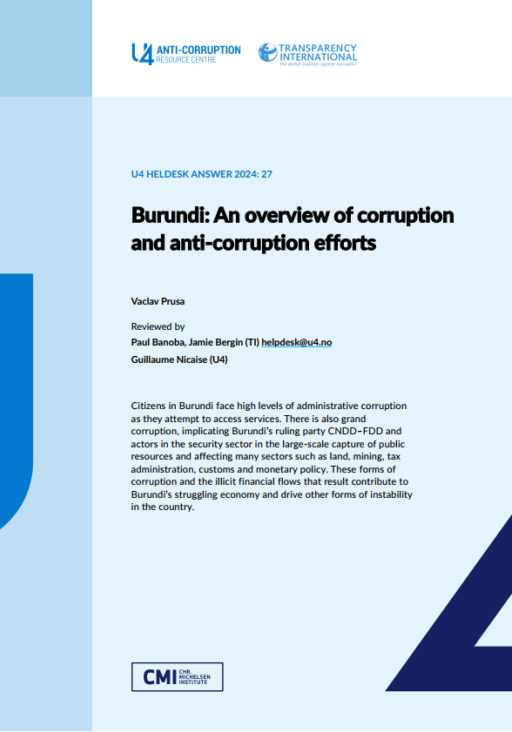
This Anti-Corruption Helpdesk brief was produced in response to a query from a U4 Partner Agency. The U4 Helpdesk is operated by Transparency International in collaboration with the U4 Anti-Corruption Resource Centre based at the Chr. Michelsen Institute.
Query
Please provide a summary of the key corruption risks in Burundi, with a focus on the foreign exchange market, land, mining and coffee sectors, and the status of anti-corruption measures, including an overview of existing interventions by international partners.
Summary
Citizens in Burundi face high levels of administrative corruption as they attempt to access services. There is also grand corruption, implicating Burundi’s ruling party CNDD–FDD and actors in the security sector in the large-scale capture of public resources and affecting many sectors such as land, mining, tax administration, customs and monetary policy. These forms of corruption and the illicit financial flows that result contribute to Burundi’s struggling economy and drive other forms of instability in the country.
Main points
- Burundi’s ruling party Conseil National pour la Défense de la Démocratie – Forces pour la Défense de la Démocratie (CNDD–FDD) and actors in the security sector are allegedly complicit in the large-scale capture of public resources, achieved through abuse of office and trading in influence.
- Between 1985 and 2013, Burundi lost an estimated US$3.7 billion in Illicit financial flows (IFFs), with significant losses from balance of payment leaks and trade misinvoicing.
- On top of this, some members of the Burundian political elite are suspected of misappropriating foreign currency reserves, contributing to structural economic damage to Burundi.
- Influential figures in politics, security and business sectors often seize public lands and natural resources, such as land for coffee plantations, without consequences.
- Corruption in tax and customs authorities facilitates organised criminal activities, such as arms trafficking, which leads to extensive revenue losses. For example, mining companies and cooperatives frequently collude with state officials and underreport their production to avoid taxes and reduce the risk of extortion, and bypass screening processes at Burundi international airport and land border crossings.
- The main drivers of corruption are weak institutions, the lack of transparency, the lack of accountability through elections, low public salaries, ethnic politics, the suppression of most forms of civic engagement and the high levels of impunity facilitated by a lack of judicial independence.
- While Burundi is a signatory of key treaties such as the UNCAC and a member of regional networks, its legal and institutional anti-corruption framework is undermined by weak institutions lacking independence and the absence of anti-corruption legislative measures, such as beneficial ownership and asset declaration
Contents
- Introduction
- Extent of corruption
- Main forms of corruption
- Drivers of corruption
- Main sectors affected by corruption
- Legal and institutional anti-corruption framework
- Annex
- References
Authors
Vaclav Prusa
Reviewed by
Paul Banoba, Jamie Bergin (TI) [email protected]
Guillaume Nicaise (U4)
Date
13/06/2024
Tags
 Download PDF
Download PDF
